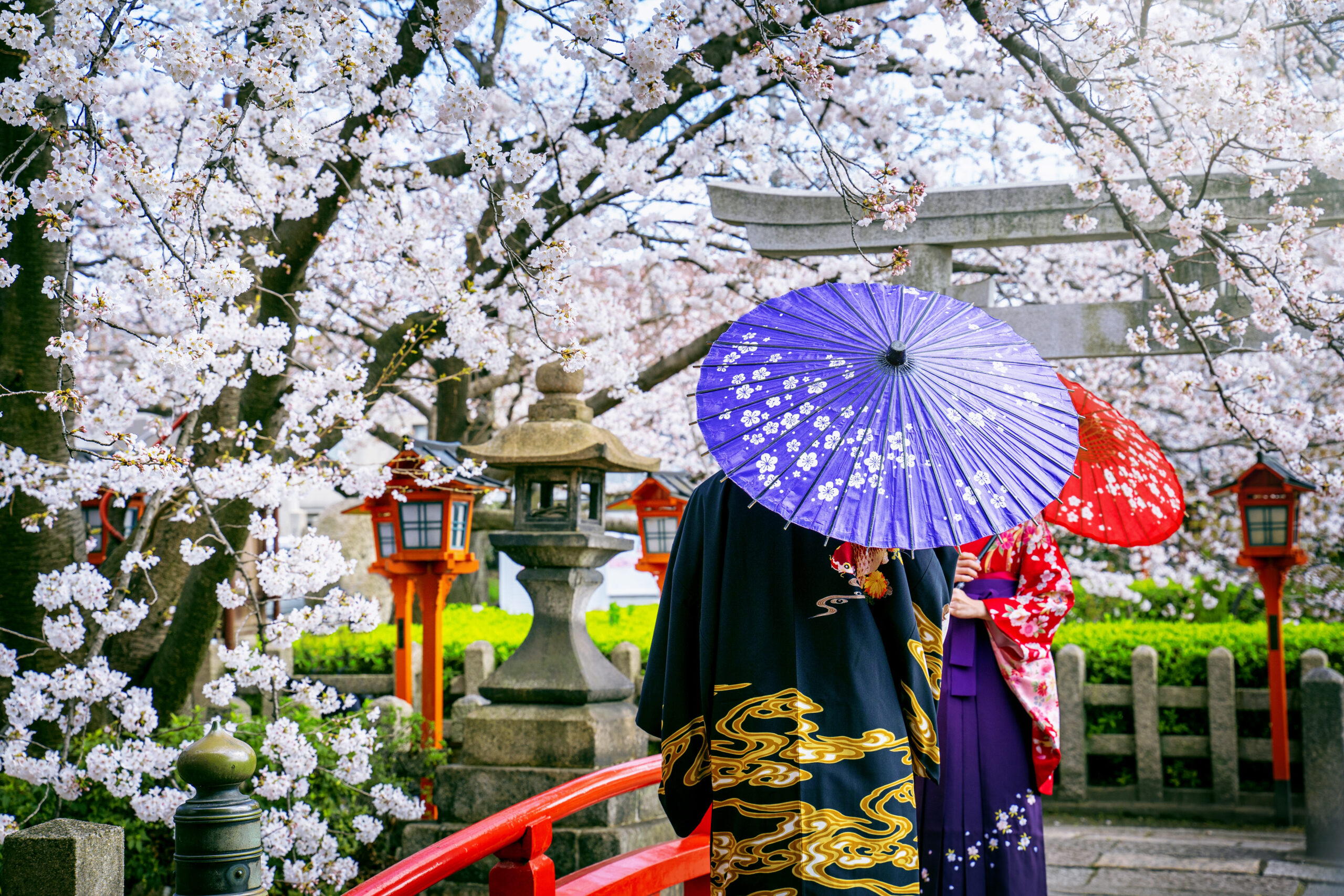Discovering the three great variations of soba in Japan
Soba, the traditional buckwheat noodles, is one of the most iconic dishes of Japanese cuisine. Although it is widespread throughout the country, each region has developed its own variant, with unique characteristics that make it special. Here are three of the most famous versions that are worth trying during a trip to Japan!

1. Togakushi Soba – The mountain delicacy of Nagano
In the heart of the Japanese Alps, the Nagano region is renowned for the quality of its soba, especially that of Togakushi. This version stands out for its artisanal preparation and presentation: the noodles are served cold on a bamboo tray called “zaru”, accompanied by a soy-based sauce (tsuyu) and often enriched with grated daikon and wasabi. The purity of the mountain water used in the preparation contributes to giving it a fresh and refined flavor.
2. Izumo Soba – The Intense Flavor of Western Japan
Originating in Shimane Prefecture, Izumo soba has a firmer texture and bold flavor thanks to the use of whole buckwheat flour, which retains the grain’s dark color and natural aroma. A distinctive feature of this variety is its serving method: often presented in “warigo,” three small stacked containers, into which sauce and condiments are poured directly, creating a mix of flavors with every bite.
3. Wanko Soba – A Unique Iwate Food Experience
More than just a dish, Wanko soba is a culinary challenge. Unique to Iwate Prefecture, this specialty involves serving small portions of soba in individual bowls, which are continually refilled by the staff until the diner gives up. It’s a fun and interactive experience, perfect for those who want to challenge themselves while enjoying the authentic taste of this regional variety.

If you are a fan of Japanese cuisine, trying these three versions of soba is an unmissable opportunity to discover the gastronomic diversity of the country. Each region offers not only a unique flavor, but also a cultural experience that enriches every trip! You can take advantage of our proposals and offers by clicking HERE: Your Japan will make your mouth water!
Discovering Japan's Most Fascinating Temples
Japan is a land where the sacred intertwines with the everyday, and temples are the ultimate expression of this. Each structure tells centuries of history, mysticism and art, offering visitors a journey through time and spirit. Follow us as we discover 5 iconic temples, unmissable stops on our Your Japan Premium Tour!

1. Kinkaku-ji – The Golden Pavilion (Kyoto)
Hidden among lush gardens and ponds, Kinkaku-ji seems to have come out of a fairy tale. Its golden walls sparkle under the sun, creating a breathtaking reflection in the surrounding pond. Originally an aristocratic villa, it became a temple in the 14th century and has enchanted everyone who visits it ever since. A walk in its zen gardens gives a sense of peace and wonder.

2. Senso-ji – The beating heart of Asakusa (Tokyo)
In the heart of frenetic Tokyo, Senso-ji represents a spiritual oasis. This Buddhist temple, the oldest in the city, welcomes visitors with the majestic Kaminarimon gate and its giant red lantern. Crossing the lively Nakamise-dori, among stalls selling traditional sweets and souvenirs, you reach the main hall, where the statue of the goddess Kannon watches over the faithful. Here, tradition and modernity blend together in a unique atmosphere.

3. Fushimi Inari Taisha – The path of a thousand gates (Kyoto)
This famous Shinto shrine is known for its infinite red torii that snake up the mountain. Each gate was donated by companies and individuals as a sign of gratitude and good luck. Walking along the path, surrounded by soft light and the sounds of nature, is a mystical experience that seems to transport you to another dimension.

4. Todai-ji – The giant of Nara
This monumental temple houses the bronze statue of the Great Buddha, 15 meters high and among the most impressive in the world. Walking among its enormous wooden columns, admiring the majesty of the structure and meeting the sacred deer in the surrounding park is an unforgettable experience.

5. Kiyomizu-dera – The panoramic balcony over Kyoto
Famous for its imposing wooden terrace suspended on the hill, Kiyomizu-dera offers a spectacular view of the city. Built without the use of nails, this temple has a special energy, especially in spring with the cherry trees in bloom and in autumn when the leaves are tinged with red.
Travel with Your Japan
Every visit to the land of the Rising Sun is an opportunity to be enchanted by its timeless beauty. Why not join us on a journey to discover not only its spirituality, but also its extraordinary duality between modernity and tradition?
With the Premium Tour by Your Japan Tour, you will live an exclusive experience along the Golden Route, exploring over 8 iconic cities including Tokyo, Kyoto, Osaka, Yokohama, Nara, Himeji and Nagoya. You will discover breathtaking landscapes, centuries-old temples and futuristic districts, immersing yourself in local customs and the most authentic gems of Japan. Thanks to our All Inclusive package, you will not have to think about a thing: transport, accommodation and over 20 cultural experiences are included, with the assistance of our experts for a stress-free and emotion-filled trip.
Summer dates available:
June 26, 2025 ~ July 10, 2025
August 5, 2025 ~ August 21, 2025
eptember 2, 2025 ~ September 16, 2025
Choose the perfect date for you and get ready to embark on an unforgettable adventure! ✨
Discover all the details here:Your Japan Tour
Two Souls of Japan: The Cultural Contrasts Between Tokyo and Osaka
Japan, a land of fascinating contrasts, finds in the cities of Tokyo and Osaka two distinct souls that reflect the cultural richness of the country. These metropolises, while sharing common historical roots, offer unique experiences that highlight the regional diversity of the Land of the Rising Sun.

Lifestyle and atmosphere
Tokyo, the vibrant capital, is the beating heart of innovation and modernity. Its glittering skyscrapers, trendy neighborhoods and impeccable efficiency of public transportation embody the essence of a city in constant movement. Walking through Shinjuku or Shibuya, you feel a frenetic pace, symbolic of a society oriented towards progress.

In contrast, Osaka exudes a more relaxed and welcoming atmosphere. Known for the hospitality of its inhabitants, the city invites spontaneous and genuine interactions. Neighborhoods such as Namba and Dotonbori are bustling with life, offering a mix of tradition and modernity that fascinates and engages.
Culinary Culture
Gastronomy is a defining element that separates Tokyo from Osaka. Tokyo, with its vast array of Michelin-starred restaurants, offers fine dining ranging from sushi to tempura, satisfying the most demanding palates.

Osaka, on the other hand, is celebrated as the "kitchen of Japan." Dishes such as okonomiyaki and takoyaki are symbols of the local culture, representing a more casual but equally delicious cuisine. The philosophy of "kuidaore," or "eat until you burst," reflects the locals' love of good food and conviviality.

Dialect and Communication
Language differences further underscore the cultural contrasts between the two cities. In Tokyo, standard Japanese is predominantly spoken, while in Osaka, the Kansai-ben dialect is widespread. Different expressions and intonations not only enrich the language, but also influence social interactions, making each conversation a unique experience.
Traditions and Customs
Local traditions further highlight the differences between Tokyo and Osaka. For example, on escalators, in Tokyo people tend to stand on the left side, while in Osaka they prefer the right side. These small variations in daily habits reflect the different mentalities and histories of the two regions.

Tokyo and Osaka are two sides of the same coin, offering different but complementary cultural experiences. Exploring both cities allows you to immerse yourself in the nuances of Japan, appreciating its complexity and intrinsic beauty. With Your Japan Tour we want to take you to discover this double soul, click HEREfor all our travel proposals!
Discovering Expo Osaka 2025
Expo 2025 Osaka promises to be one of the most fascinating events in recent years, a global celebration that combines innovation, culture and sustainability. It will take place in the iconic Japanese city of Osaka, known for its overwhelming energy, amazing food and unique charm. Let's dive into this comprehensive guide to discover everything travelers need to know about Expo and the unforgettable experiences this extraordinary event has to offer!

Photo: Wikipedia Commons
The theme of Expo 2025: "Designing Future Society for Our Lives"
Expo 2025 Osaka revolves around an ambitious and visionary theme: "Designing the Society of the Future for Our Lives". This theme invites nations, organisations and individuals to reflect on how to build a more sustainable, inclusive and innovative society. The organisers focus on three main sub-themes:
- Health and Well-being
- Environmental Sustainability
- Creating Opportunities for All
The goal is to create a global dialogue to address universal challenges such as climate change, social equality and global health.
Where and When Will the Expo Be Held?
The Expo will be held from April 13 to October 13, 2025 on the artificial island of Yumeshima, in Osaka Bay. This innovative and futuristic location perfectly represents the spirit of the event, with large open spaces, cutting-edge pavilions and a particular focus on sustainability. Yumeshima, whose name means "Island of Dreams", was chosen not only for its strategic location but also for the possibility of transforming it into a hub of innovation and creativity.

Photo: Wikipedia Commons
What to Expect at the Expo
Expo 2025 will host over 150 countries and numerous international organizations, each with its own unique pavilion:
- Thematic Pavilions
The pavilions will be designed to inspire and engage visitors. There will be sections dedicated to emerging technologies, sustainable solutions and futuristic visions, all presented through interactive installations, artistic exhibitions and experiential activities. - Technological Innovations
Demonstrations of the world's most advanced technologies, such as artificial intelligence, robotics, renewable energy and biotechnology. The Expo will be a showcase of how these innovations can transform society and improve the quality of life. - Events and Shows
During the six months of the event, there will be concerts, artistic performances, workshops, and talk shows with global experts. Cultural festivals and traditions brought by the various participating countries will enrich the atmosphere. - Global Gastronomy
The Expo will also be a culinary journey like no other, with a wide range of booths and restaurants offering authentic dishes from around the world, alongside local Osaka cuisine, famous for specialties such as takoyaki and okonomiyaki.
Expo 2025 Osaka is not just an event, but a unique opportunity to be part of a global vision of the future. It is a celebration of human creativity, an invitation to reflect on what we can do together to build a better world.
Plan your trip with us today and prepare to have an extraordinary experience combining culture, innovation, and a pinch of Japanese magic! Your Japan takes you right to discover the Osaka Expo! With our All-inclusive options, you won't have to worry about a thing. Our tour leaders will take care of everything; all you have to do is pack your bags! Come and discover the available packages and discounts now HERE
The most beautiful winter destinations in Japan: a journey through snow, lights and tradition
Winter in Japan is not just a season, but a poem of slowly falling snow, temples wrapped in silence and lights that light up the cities. With its unique mix of enchanting landscapes and timeless traditions, the Land of the Rising Sun in this season offers experiences that warm the heart, despite the cold. If you dream of living a fairytale trip, here are some of the unmissable destinations for an unforgettable vacation:

1. Shirakawa-go: The Fairytale Village
Tucked away in the Japanese Alps, Shirakawa-go seems to have come straight out of a storybook. This historic village, a UNESCO World Heritage Site, is famous for its gassho-zukuri-style houses, with snow-covered sloping roofs that resemble hands clasped in prayer. Visit during the nighttime illuminations: the lights that envelop the houses create a magical atmosphere, perfect for taking unforgettable photos.
2. Sapporo and the Snow Festival
If you love snow, Sapporo is a must-see. The capital of the island of Hokkaido, this city is famous for its Yuki Matsuri, the Snow Festival, held in February. Here you can admire incredible ice and snow sculptures, as big as buildings, and enjoy winter activities such as skiing and snowboarding. After a day in the cold, nothing beats a steaming bowl of miso ramen, a local speciality.

3. Kyoto: Temples under the snow
Kyoto is fascinating in every season, but in winter it transforms into a dream place. Imagine the Kinkaku-ji (the Golden Pavilion) surrounded by sparkling snow or a walk along the bamboo path of Arashiyama immersed in a muffled silence. It is the perfect destination for those seeking romance and tranquillity, as well as splendid photographic views.

4. Hakuba: Winter Sports Paradise
Mountain lovers can’t miss Hakuba, a ski resort complex in the Japanese Alps. With over 200 slopes and breathtaking scenery, Hakuba offers the perfect balance between adrenaline and relaxation. And when the sun goes down, treat yourself to a soak in an outdoor onsen, surrounded by snow and steam: pure bliss.
5. Nikko: Spirituality and Nature
A few hours from Tokyo, Nikko is a combination of nature and culture. In winter, frozen waterfalls like Kegon and majestic temples like Toshogu, framed by snow, create a mystical atmosphere. After exploring, try yuba (soybean tofu), a local speciality that will warm your body and soul.
6. Kanazawa: between tradition and modernity
Known as the little Kyoto, Kanazawa is famous for its gardens and traditional neighbourhoods. In winter, Kenrokuen Garden, considered one of the most beautiful in Japan, is a marvel: snow-covered trees and soft lights create an almost surreal landscape. Don't miss the Omicho market, where you can taste fresh crab, a winter delicacy.
7. Kusatsu: Relax in the Hot Springs
Finally, for an experience that combines relaxation and tradition, head to Kusatsu, one of the most famous hot spring resorts in Japan. Here you can immerse yourself in the warm waters of the onsen while snowflakes fall around you. There is nothing more regenerating than a hot bath surrounded by winter nature.
8. Ginzan Onsen: A leap into the past
If you’re dreaming of a postcard-like winter experience, Ginzan Onsen is the perfect place. This small onsen village in Yamagata Prefecture seems frozen in time, with its historic wooden inns (ryokans) lit by lanterns, overlooking a river that flows through snow-covered streets. At night, the view is simply magical. Immersing yourself in the hot waters of the onsen while it snows outside is an experience you’ll never forget. Perfect for those seeking romance and relaxation away from the chaos of the city.

Why choose Japanese winter?
In Japan, winter is not just a season but a sensory experience. It is the taste of matcha sweets accompanied by a cup of hot tea, the sound of fresh snow under your feet, and the sight of cities lit up by thousands of Christmas lights. It is the warmth of traditions, such as the tea ceremony, and the wonder of discovering a side of Japan that few tourists see.
Whether you are looking for adventure, romance or relaxation, winter has something special for everyone. Pack your bags and let yourself be enchanted… why not travel with us? Your Japan Tour has great surprises in store! Click HERE for more information!
Tokyo and the crossroads: Not just Shibuya Scramble
Imagine being immersed in vibrant and dynamic Tokyo, a place where every corner holds a surprise and every street tells a story. Shibuya Crossing is perhaps the epicenter of this overwhelming energy, an iconic symbol immortalized in countless shots. Here, the imposing commercial buildings, the glittering advertising signs and the incessant stream of pedestrians create a unique, almost magical atmosphere. But if your desire is to explore lesser-known, equally fascinating corners, here are five intersections of Tokyo that will make you fall in love with this city even more.

Credits: Savvytokyo
Sukiyabashi Crossing
The first is the Sukiyabashi Crossing in Ginza, a true hidden gem that offers a similar visual and sensory experience to Shibuya. The white and orderly pedestrian lines, together with the vitality of Ginza Sony Park and Sukiyabashi Park, create a futuristic and vibrant atmosphere. But what really makes this intersection special is the majestic Tokyu Plaza Ginza, with its façade inspired by Edo Kiriko glass. Known as the "Gateway to Ginza", this place defines the elegance and luxury of Tokyo's shopping district.

Credits: A. Wee
Nissan Crossing
Continuing into the heart of Ginza, you will find yourself at the intersection of Seiko House Ginza. This spot evokes the glamour of New York's Fifth Avenue, with its glittering shop windows and refined architecture. Here, Japanese luxury is palpable: on the one hand, the sophisticated Seiko watches; on the other, Nissan's cutting-edge cars and the innovative Sony showroom. Every corner exudes elegance and craftsmanship of the highest standard.

Credits japantravel.navitime.com
Roppongi Crossing
Moving to Roppongi, we find an intersection that shines especially at night. The lights of the skyscrapers illuminate the sky, creating an enchanting atmosphere. Roppongi Crossing is crossed by the Metropolitan Expressway, an imposing structure that adds a touch of urban grandeur. The "Roppongi" signs on the freeway are an unmistakable landmark, a symbol of this lively and cosmopolitan neighbourhood. When in the area, don't miss the opportunity to visit one of the many trendy bars in Roppongi.

Credits B.Lucava
Kabukicho Crossing
Another unmissable intersection is Kabukicho in Shinjuku. Here, Godzilla's head poking out of the Toho Cinema provides a surreal and iconic scene. Kabukicho is the beating heart of Tokyo's nightlife, with its neon signs, restaurants and bars crowded with students and salarymen. This red-light district, with its mix of pop culture and lively energy, offers endless photo opportunities and a unique experience.

Credits J. Jenkin
Asakusa Crossing
Finally, we cannot forget Asakusa Crossing, which marks the entrance to Nakamise-dori and leads to the majestic Sensoji Temple. This is one of the most recognizable views of Tokyo, dominated by the Kaminarimon Gate with its imposing lantern. The atmosphere here is steeped in history and tradition, enriched by the rickshaws that await tourists at the entrance. Crossing the street, you will find the Asakusa Culture Tourist Information Center, designed by Kengo Kuma, where you can enjoy breathtaking views of the surrounding area.
These crossings represent the essence of Tokyo, a city that knows how to surprise and fascinate every corner. Get ready to discover the magic that lies in these urban wonders and be inspired by their unique beauty.
Tokyo among the most affordable cities for 2024
Tokyo ranked among the most affordable tourist destinations of 2024, so this year is the right time to pack your suitcase and set off for the Rising Sun!
Also due to the fall of the yen, for all foreign tourists, this has actually become an important opportunity to seize to visit the Japanese capital.
It's true, the journey to get to your destination is long and sometimes expensive, but once you arrive in Tokyo, daily life is really convenient. In fact, the prices you can see at restaurants are often a third of those we are used to here in Italy.
But not only! Traveling by public transport is also really convenient. In fact, let's not forget that thanks to the Japan Rail Pass and to the legendary Yamanote Line, for a tourist, experiencing the city becomes incredibly practical and simple.
In recent years, since travel has reopened, we have seen a notable increase in the number of visitors to Japan. Interest in the land of the Rising Sun, and in particular Tokyo, does not seem to be waning.

In fact, a recent Post Office survey ranks Tokyo as the fourth most convenient tourist destination in the world.
The top 10
- Hoi An, Vietnam
- Cape Town, South Africa
- Mombasa, Kenya
- Tokyo, Japan
- Algarve, Portugal
- Sharm el-Sheikh, Egypt
- Sunny beach, Bulgaria
- Kuta, Bali
- Marmaris, Türkiye
- Paphos, Cyprus
Tokyo has a reputation for being one of the most affordable destinations even before the recent economic situation, so there will certainly be many opportunities to visit the city in the future too.
Your Japan Tour: Travel with us
Japan Italy Bridge has just launched its exclusive “Your Japan”, a trip to Japan tailor-made for Italian tourists. This autumn, you will have the chance to go with us to Tokyo. An All Inclusive experience that will allow you to discover the beauties of the capital of Japan. Japan Italy Bridge will take care of everything, from booking flights and hotels to planning your travel plan. Furthermore, our guides will leave with you from Italy and will accompany you along the entire Japanese route.
So what are you waiting for? The time has come to pack your suitcase and travel with us!
Mount Fuji view from Lawson store in Kawaguchiko will be no longer possible
Tourists are the lifeblood of many places' economies, bringing with them opportunities and growth. However, they often disrespect the places and people they encounter, leaving waste and disorder behind. It is essential to travel with an open heart and an educational perspective, valuing and protecting the wonders that welcome us otherwise the decision made by the inhabitants of Kawaguchiko, Japan, could be repeated endlessly involving other beloved destinations worldwide.
But what exactly happened?
The protagonist of this story is Mount Fuji. We are in the town of Kawaguchiko where, every day, the small convenience store of the Lawson chain becomes the stage for a large number of visitors eager to immortalise its bright blue facade, which offers a breathtaking contrast with the majestic peak of Fuji-san. So far, nothing strange, except that the massive influx of tourists has generated significant problems, such as blocking sidewalks, illegal parking, etc., even crossing the road wildly, putting everyone's safety at risk to get the perfect shot. The dental clinic in front of the convenience store was particularly affected, with people blocking the entrance and even climbing onto the roof to improve the view! Despite the multilingual signs to warn visitors of their dangerous behaviour, there have been no improvements and this has forced the city to plan more severe interventions to manage the situation.

Work began on April 30 to install barriers measuring about 2.5 meters high and 20 meters long in front of the convenience store, to prevent people from parking on the opposite side of the road and reduce disruption to the dental clinic and nearby businesses. The Asahi Shimbun, a major Japanese newspaper known for its in-depth coverage of domestic and international news and recognized for its quality journalism and influence in the Japanese media landscape, reported that six iron fences, each three meters wide, will be placed along the road to prevent pedestrians from crossing dangerously. Construction of the barriers, scheduled for the first week of May, has been postponed due to difficulties in obtaining materials. An official told The Japan Times that the missing parts will arrive around May 20, allowing work to resume on completing the barrier.
Lawson has since issued an official apology to residents, businesses and others who have been inconvenienced by traffic in front of the store. The company is also considering deploying security personnel to help manage the situation. This is just one of the measures local governments in Japan have had to take to address the problem of overtourism. A similar example has been seen in Kyoto, where the government recently introduced multiple measures to ban foreigners from trespassing on private streets without permission, in response to tourists photographing and harassing maiko, the young women who undertake rigorous training to become geisha, disrupting residents and businesses.
Where to see and photograph Mount Fuji
Don't despair though! There are many other points from which you can admire the highest peak in Japan, always with the utmost respect for the inhabitants! Here are some:
- Arakurayama Sengen Park, famous for the Chureito pagoda with Mount Fuji in the background;
- Lake Kawaguchi, particularly evocative during the cherry blossom season;
- Oishi Park, which offers a splendid view of Mount Fuji surrounded by fields of colourful flowers;
- Fuji Sengen Shrine is a historic starting point for pilgrims who climb the sacred mountain.

We hope we never read news like this again. What do you think? Do you think the installation of these huge panels is right, or would you have opted for some other kind of measure? Let us know in the comments!
Travel with us
If you are also curious to see this incredible show, Japan Italy Bridge has just launched its exclusive “Your Japan”, a trip to Japan tailor-made for Italian tourists. This autumn, you will have the chance to go with us to Tokyo. An All Inclusive experience that will allow you to discover the beauties of the capital of Japan. Japan Italy Bridge will take care of everything, from booking flights and hotels to planning your travel plan. Furthermore, our guides will leave with you from Italy and will accompany you along the entire Japanese route.
So what are you waiting for? The time has come to pack your suitcase and travel with us!














